HI5020 Corporate Accounting: Detailed Financial Statement Analysis
VerifiedAdded on 2024/05/31
|14
|2816
|407
Report
AI Summary
This report provides a comprehensive analysis of corporate accounting principles, focusing on the financial statements of BlueScope Steel Limited. It examines the cash flow statement, differentiating between operating, investing, and financing activities, and offers a comparative analysis across multiple years. The report also discusses the other comprehensive income statement, explaining items that may or may not be reclassified to profit or loss. Furthermore, it delves into accounting for corporate income tax, reconciling the company's tax expense with its accounting income, and analyzing deferred tax assets and liabilities. The analysis includes interesting observations and insights gained from examining the company's tax treatment in its financial statements. Desklib provides this and other solved assignments to aid students in their studies.
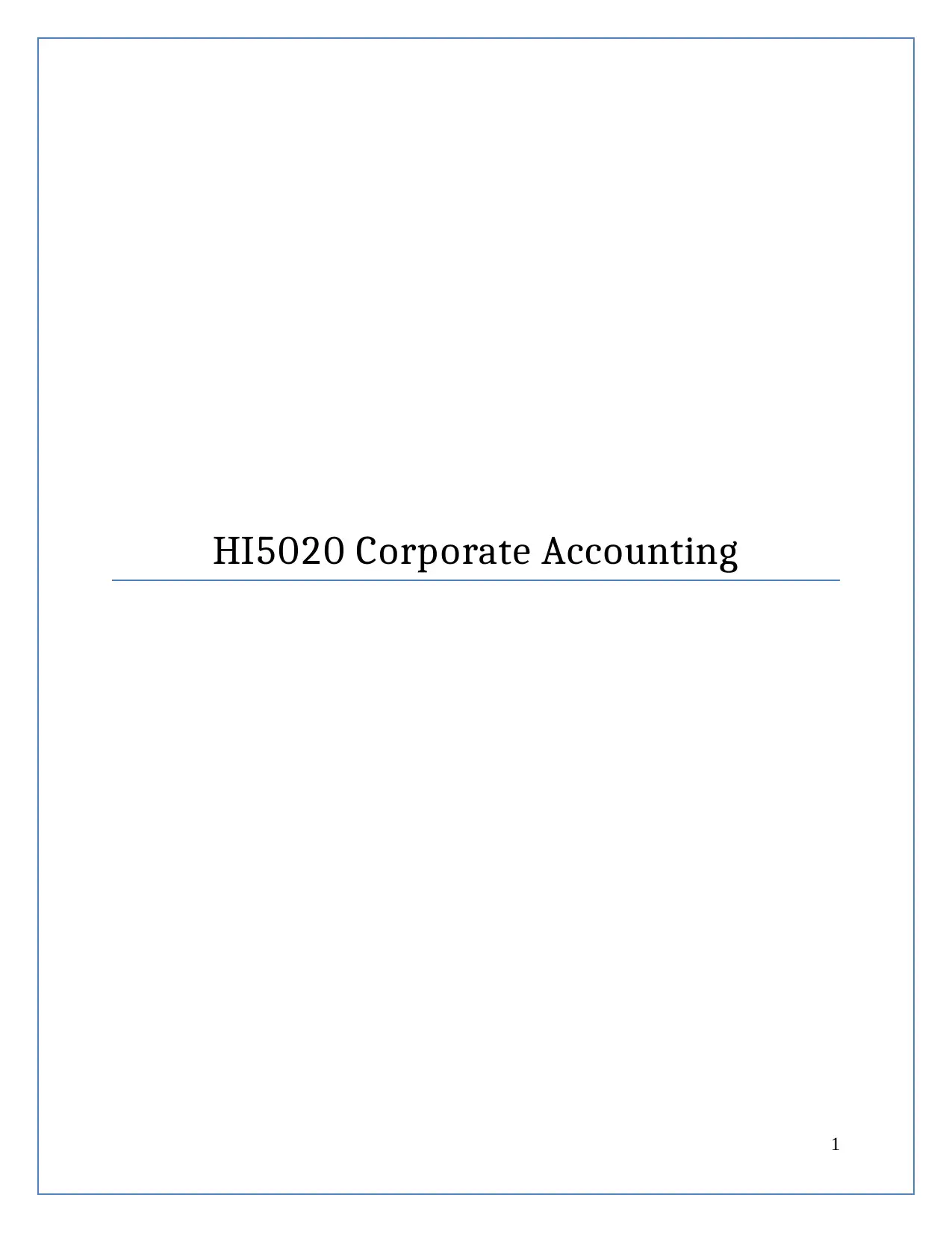
HI5020 Corporate Accounting
1
1
Paraphrase This Document
Need a fresh take? Get an instant paraphrase of this document with our AI Paraphraser
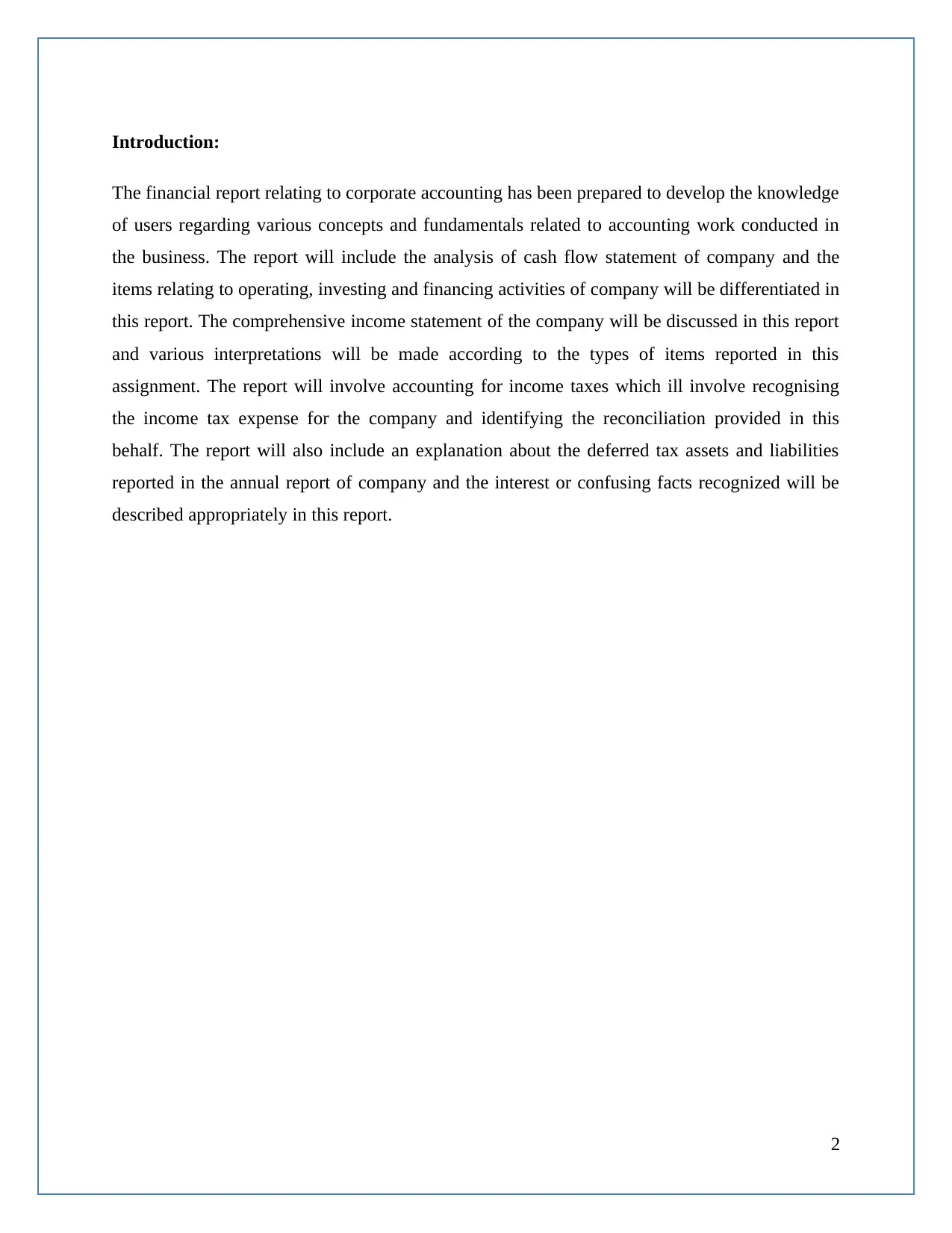
Introduction:
The financial report relating to corporate accounting has been prepared to develop the knowledge
of users regarding various concepts and fundamentals related to accounting work conducted in
the business. The report will include the analysis of cash flow statement of company and the
items relating to operating, investing and financing activities of company will be differentiated in
this report. The comprehensive income statement of the company will be discussed in this report
and various interpretations will be made according to the types of items reported in this
assignment. The report will involve accounting for income taxes which ill involve recognising
the income tax expense for the company and identifying the reconciliation provided in this
behalf. The report will also include an explanation about the deferred tax assets and liabilities
reported in the annual report of company and the interest or confusing facts recognized will be
described appropriately in this report.
2
The financial report relating to corporate accounting has been prepared to develop the knowledge
of users regarding various concepts and fundamentals related to accounting work conducted in
the business. The report will include the analysis of cash flow statement of company and the
items relating to operating, investing and financing activities of company will be differentiated in
this report. The comprehensive income statement of the company will be discussed in this report
and various interpretations will be made according to the types of items reported in this
assignment. The report will involve accounting for income taxes which ill involve recognising
the income tax expense for the company and identifying the reconciliation provided in this
behalf. The report will also include an explanation about the deferred tax assets and liabilities
reported in the annual report of company and the interest or confusing facts recognized will be
described appropriately in this report.
2
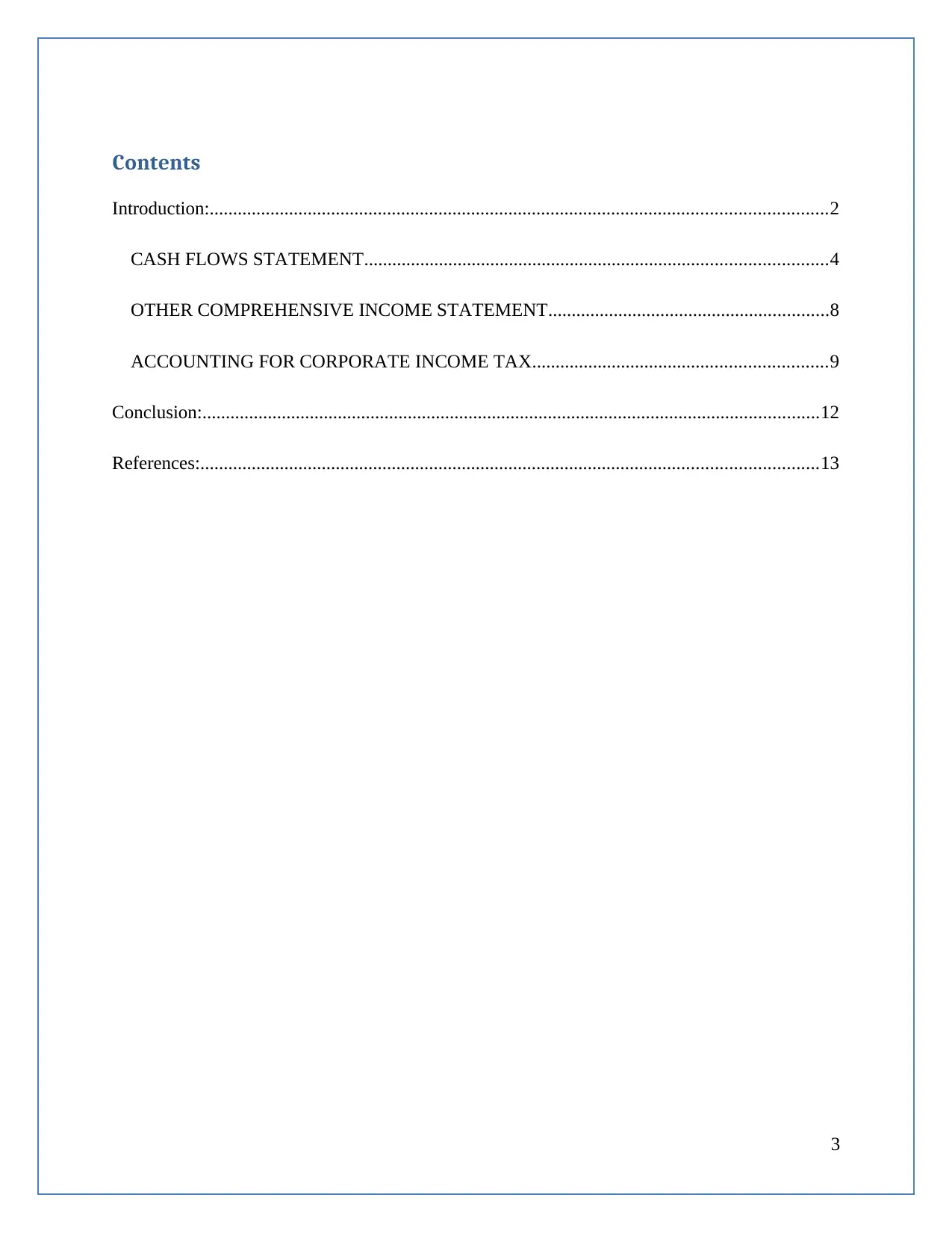
Contents
Introduction:....................................................................................................................................2
CASH FLOWS STATEMENT...................................................................................................4
OTHER COMPREHENSIVE INCOME STATEMENT............................................................8
ACCOUNTING FOR CORPORATE INCOME TAX...............................................................9
Conclusion:....................................................................................................................................12
References:....................................................................................................................................13
3
Introduction:....................................................................................................................................2
CASH FLOWS STATEMENT...................................................................................................4
OTHER COMPREHENSIVE INCOME STATEMENT............................................................8
ACCOUNTING FOR CORPORATE INCOME TAX...............................................................9
Conclusion:....................................................................................................................................12
References:....................................................................................................................................13
3
⊘ This is a preview!⊘
Do you want full access?
Subscribe today to unlock all pages.

Trusted by 1+ million students worldwide
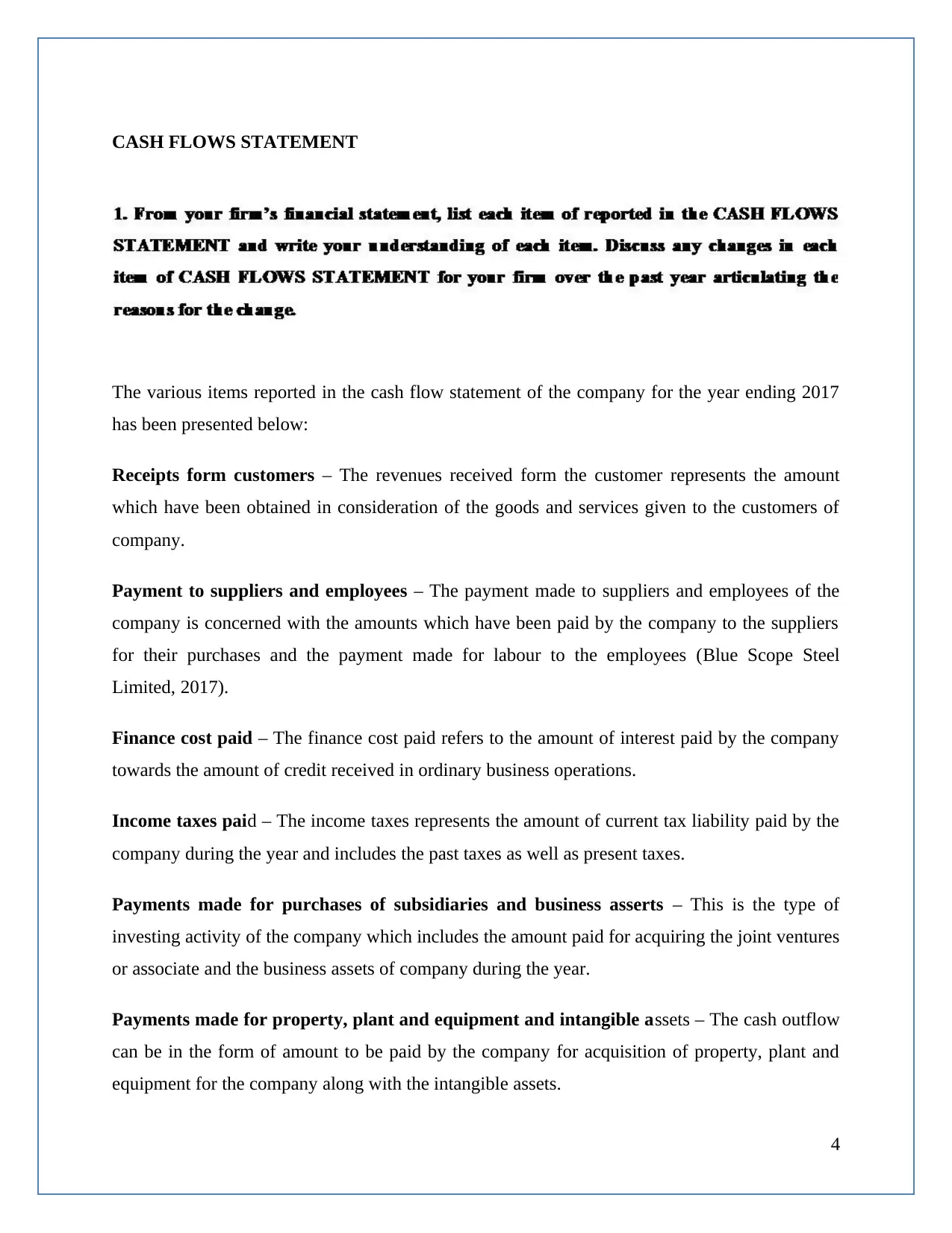
CASH FLOWS STATEMENT
The various items reported in the cash flow statement of the company for the year ending 2017
has been presented below:
Receipts form customers – The revenues received form the customer represents the amount
which have been obtained in consideration of the goods and services given to the customers of
company.
Payment to suppliers and employees – The payment made to suppliers and employees of the
company is concerned with the amounts which have been paid by the company to the suppliers
for their purchases and the payment made for labour to the employees (Blue Scope Steel
Limited, 2017).
Finance cost paid – The finance cost paid refers to the amount of interest paid by the company
towards the amount of credit received in ordinary business operations.
Income taxes paid – The income taxes represents the amount of current tax liability paid by the
company during the year and includes the past taxes as well as present taxes.
Payments made for purchases of subsidiaries and business asserts – This is the type of
investing activity of the company which includes the amount paid for acquiring the joint ventures
or associate and the business assets of company during the year.
Payments made for property, plant and equipment and intangible assets – The cash outflow
can be in the form of amount to be paid by the company for acquisition of property, plant and
equipment for the company along with the intangible assets.
4
The various items reported in the cash flow statement of the company for the year ending 2017
has been presented below:
Receipts form customers – The revenues received form the customer represents the amount
which have been obtained in consideration of the goods and services given to the customers of
company.
Payment to suppliers and employees – The payment made to suppliers and employees of the
company is concerned with the amounts which have been paid by the company to the suppliers
for their purchases and the payment made for labour to the employees (Blue Scope Steel
Limited, 2017).
Finance cost paid – The finance cost paid refers to the amount of interest paid by the company
towards the amount of credit received in ordinary business operations.
Income taxes paid – The income taxes represents the amount of current tax liability paid by the
company during the year and includes the past taxes as well as present taxes.
Payments made for purchases of subsidiaries and business asserts – This is the type of
investing activity of the company which includes the amount paid for acquiring the joint ventures
or associate and the business assets of company during the year.
Payments made for property, plant and equipment and intangible assets – The cash outflow
can be in the form of amount to be paid by the company for acquisition of property, plant and
equipment for the company along with the intangible assets.
4
Paraphrase This Document
Need a fresh take? Get an instant paraphrase of this document with our AI Paraphraser
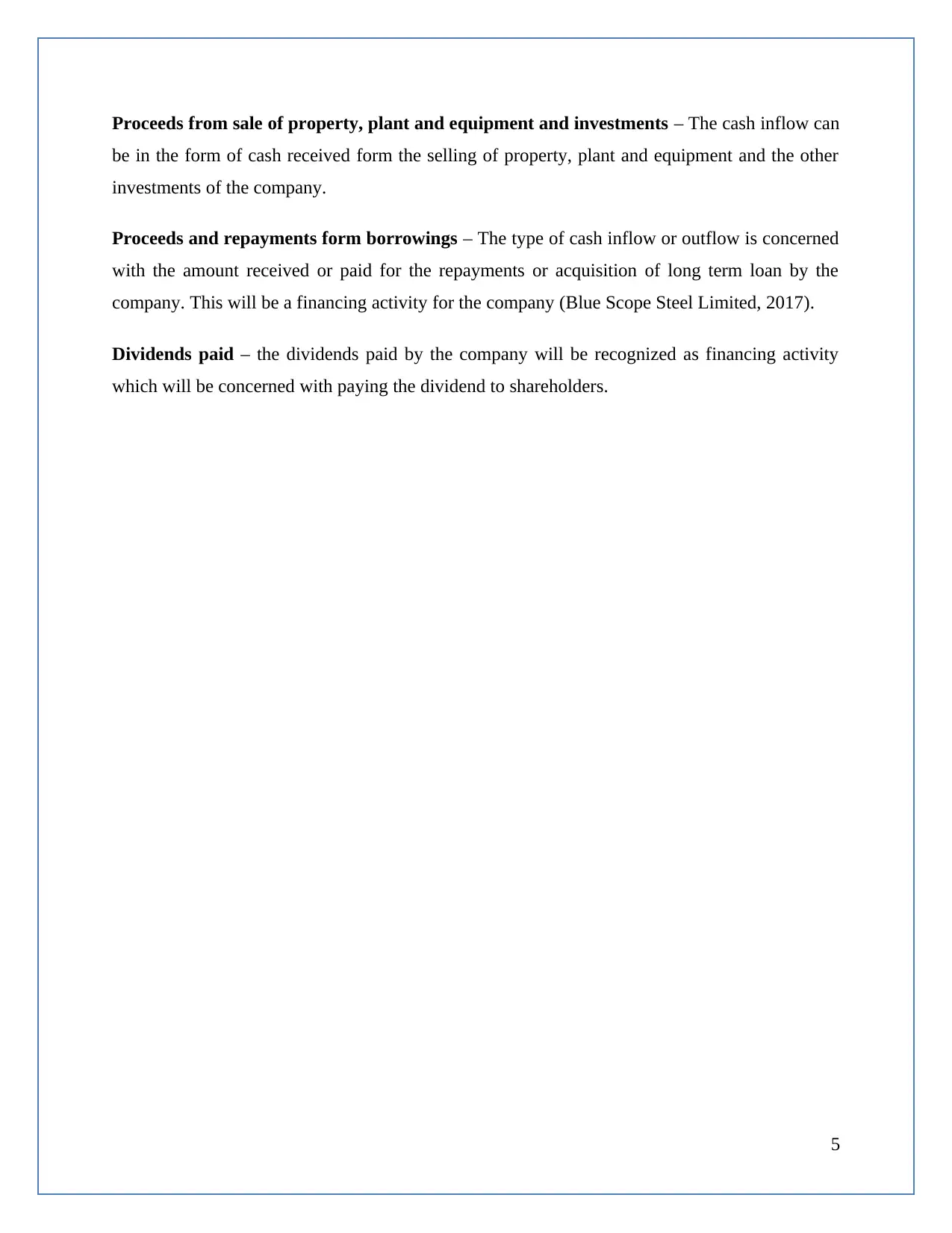
Proceeds from sale of property, plant and equipment and investments – The cash inflow can
be in the form of cash received form the selling of property, plant and equipment and the other
investments of the company.
Proceeds and repayments form borrowings – The type of cash inflow or outflow is concerned
with the amount received or paid for the repayments or acquisition of long term loan by the
company. This will be a financing activity for the company (Blue Scope Steel Limited, 2017).
Dividends paid – the dividends paid by the company will be recognized as financing activity
which will be concerned with paying the dividend to shareholders.
5
be in the form of cash received form the selling of property, plant and equipment and the other
investments of the company.
Proceeds and repayments form borrowings – The type of cash inflow or outflow is concerned
with the amount received or paid for the repayments or acquisition of long term loan by the
company. This will be a financing activity for the company (Blue Scope Steel Limited, 2017).
Dividends paid – the dividends paid by the company will be recognized as financing activity
which will be concerned with paying the dividend to shareholders.
5
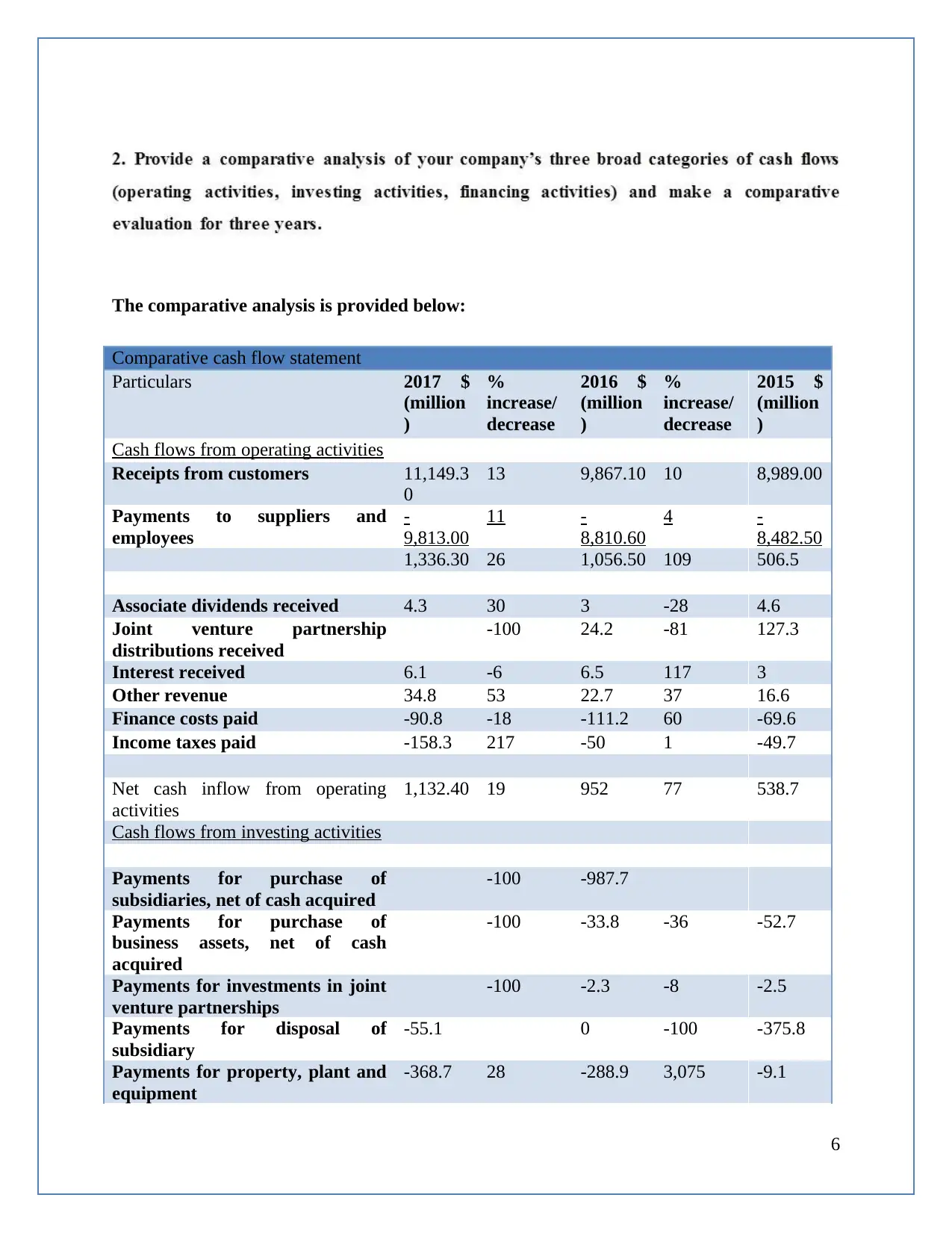
The comparative analysis is provided below:
Comparative cash flow statement
Particulars 2017 $
(million
)
%
increase/
decrease
2016 $
(million
)
%
increase/
decrease
2015 $
(million
)
Cash flows from operating activities
Receipts from customers 11,149.3
0
13 9,867.10 10 8,989.00
Payments to suppliers and
employees
-
9,813.00
11 -
8,810.60
4 -
8,482.50
1,336.30 26 1,056.50 109 506.5
Associate dividends received 4.3 30 3 -28 4.6
Joint venture partnership
distributions received
-100 24.2 -81 127.3
Interest received 6.1 -6 6.5 117 3
Other revenue 34.8 53 22.7 37 16.6
Finance costs paid -90.8 -18 -111.2 60 -69.6
Income taxes paid -158.3 217 -50 1 -49.7
Net cash inflow from operating
activities
1,132.40 19 952 77 538.7
Cash flows from investing activities
Payments for purchase of
subsidiaries, net of cash acquired
-100 -987.7
Payments for purchase of
business assets, net of cash
acquired
-100 -33.8 -36 -52.7
Payments for investments in joint
venture partnerships
-100 -2.3 -8 -2.5
Payments for disposal of
subsidiary
-55.1 0 -100 -375.8
Payments for property, plant and
equipment
-368.7 28 -288.9 3,075 -9.1
6
Comparative cash flow statement
Particulars 2017 $
(million
)
%
increase/
decrease
2016 $
(million
)
%
increase/
decrease
2015 $
(million
)
Cash flows from operating activities
Receipts from customers 11,149.3
0
13 9,867.10 10 8,989.00
Payments to suppliers and
employees
-
9,813.00
11 -
8,810.60
4 -
8,482.50
1,336.30 26 1,056.50 109 506.5
Associate dividends received 4.3 30 3 -28 4.6
Joint venture partnership
distributions received
-100 24.2 -81 127.3
Interest received 6.1 -6 6.5 117 3
Other revenue 34.8 53 22.7 37 16.6
Finance costs paid -90.8 -18 -111.2 60 -69.6
Income taxes paid -158.3 217 -50 1 -49.7
Net cash inflow from operating
activities
1,132.40 19 952 77 538.7
Cash flows from investing activities
Payments for purchase of
subsidiaries, net of cash acquired
-100 -987.7
Payments for purchase of
business assets, net of cash
acquired
-100 -33.8 -36 -52.7
Payments for investments in joint
venture partnerships
-100 -2.3 -8 -2.5
Payments for disposal of
subsidiary
-55.1 0 -100 -375.8
Payments for property, plant and
equipment
-368.7 28 -288.9 3,075 -9.1
6
⊘ This is a preview!⊘
Do you want full access?
Subscribe today to unlock all pages.

Trusted by 1+ million students worldwide

Payments for intangibles -14.3 -43 -25 -213 22.1
Proceeds from sale of property,
plant and equipment
3.2 -68 10.1 40 7.2
Proceeds from sale of investments 26.6 -30 38.1 0
Net cash (outflow) from investing
activities
-408.3 -68 -
1,289.50
214 -410.8
Cash flows from financing activities
Proceeds from borrowings 1,261.50 -71 4,290.70 103 2,114.80
Repayment of borrowings -
1,516.20
-61 -
3,849.80
78 -
2,165.90
Dividends paid to Company's
shareholders
-40.2 18 -34.2 101 -17
Dividends paid to non-controlling
interests in subsidiaries
-63.4 63 -38.8 -16 -46.2
Transactions with non-controlling
interests
-100 -0.5
Share buybacks -150.4 0 -100 -0.6
Net cash inflow from financing
activities
-508.7 -238 367.9 -419 -115.4
Net increase in cash and cash
equivalents
215.4 609 30.4 143 12.5
Cash and cash equivalents at the
beginning of the financial year
548.9 6 517.9 11 465.9
Effects of exchange rate changes
on cash and cash equivalents
-12.4 -2,167 0.6 -98 39.5
Cash and cash equivalents at the end
of the financial year
751.9 37 548.9 6 517.9
Analysis:
Cash flows from operating activities: The cash flows from operating activities have resulted in
an increase in inflows by 19% in the year 2017 and the same has increased by 77% in the year
2016. The main reason behind such an increase is associated with increase in amounts received
by joint venture partnership distributions received (Beekes, et aussi. al., 2015).
Cash flow from investing activities– The net cash outlay form investing activates have
decreased significantly in the year 2017 which has been 68% decreased however this has
increased in the year 2016 by 214%.
7
Proceeds from sale of property,
plant and equipment
3.2 -68 10.1 40 7.2
Proceeds from sale of investments 26.6 -30 38.1 0
Net cash (outflow) from investing
activities
-408.3 -68 -
1,289.50
214 -410.8
Cash flows from financing activities
Proceeds from borrowings 1,261.50 -71 4,290.70 103 2,114.80
Repayment of borrowings -
1,516.20
-61 -
3,849.80
78 -
2,165.90
Dividends paid to Company's
shareholders
-40.2 18 -34.2 101 -17
Dividends paid to non-controlling
interests in subsidiaries
-63.4 63 -38.8 -16 -46.2
Transactions with non-controlling
interests
-100 -0.5
Share buybacks -150.4 0 -100 -0.6
Net cash inflow from financing
activities
-508.7 -238 367.9 -419 -115.4
Net increase in cash and cash
equivalents
215.4 609 30.4 143 12.5
Cash and cash equivalents at the
beginning of the financial year
548.9 6 517.9 11 465.9
Effects of exchange rate changes
on cash and cash equivalents
-12.4 -2,167 0.6 -98 39.5
Cash and cash equivalents at the end
of the financial year
751.9 37 548.9 6 517.9
Analysis:
Cash flows from operating activities: The cash flows from operating activities have resulted in
an increase in inflows by 19% in the year 2017 and the same has increased by 77% in the year
2016. The main reason behind such an increase is associated with increase in amounts received
by joint venture partnership distributions received (Beekes, et aussi. al., 2015).
Cash flow from investing activities– The net cash outlay form investing activates have
decreased significantly in the year 2017 which has been 68% decreased however this has
increased in the year 2016 by 214%.
7
Paraphrase This Document
Need a fresh take? Get an instant paraphrase of this document with our AI Paraphraser
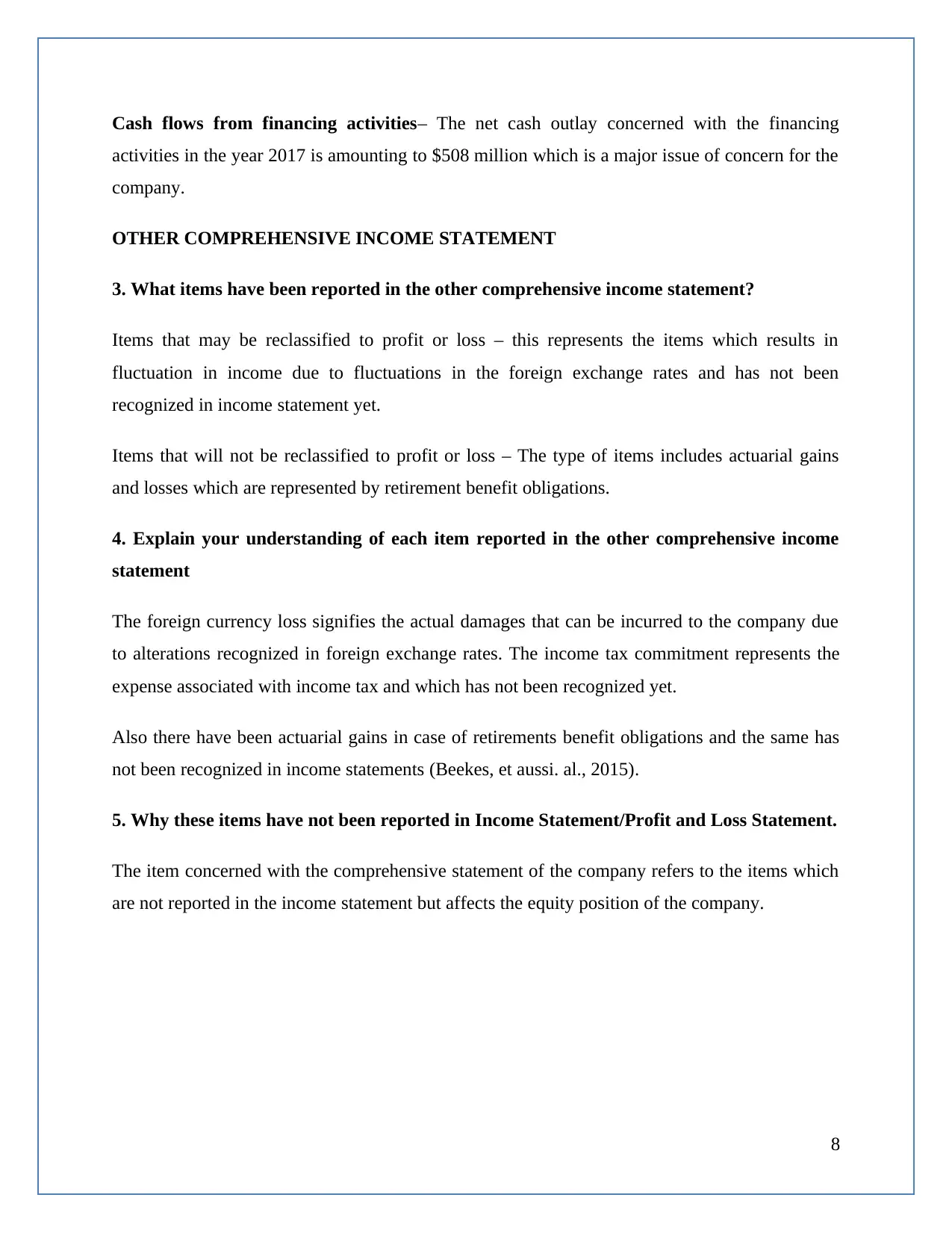
Cash flows from financing activities– The net cash outlay concerned with the financing
activities in the year 2017 is amounting to $508 million which is a major issue of concern for the
company.
OTHER COMPREHENSIVE INCOME STATEMENT
3. What items have been reported in the other comprehensive income statement?
Items that may be reclassified to profit or loss – this represents the items which results in
fluctuation in income due to fluctuations in the foreign exchange rates and has not been
recognized in income statement yet.
Items that will not be reclassified to profit or loss – The type of items includes actuarial gains
and losses which are represented by retirement benefit obligations.
4. Explain your understanding of each item reported in the other comprehensive income
statement
The foreign currency loss signifies the actual damages that can be incurred to the company due
to alterations recognized in foreign exchange rates. The income tax commitment represents the
expense associated with income tax and which has not been recognized yet.
Also there have been actuarial gains in case of retirements benefit obligations and the same has
not been recognized in income statements (Beekes, et aussi. al., 2015).
5. Why these items have not been reported in Income Statement/Profit and Loss Statement.
The item concerned with the comprehensive statement of the company refers to the items which
are not reported in the income statement but affects the equity position of the company.
8
activities in the year 2017 is amounting to $508 million which is a major issue of concern for the
company.
OTHER COMPREHENSIVE INCOME STATEMENT
3. What items have been reported in the other comprehensive income statement?
Items that may be reclassified to profit or loss – this represents the items which results in
fluctuation in income due to fluctuations in the foreign exchange rates and has not been
recognized in income statement yet.
Items that will not be reclassified to profit or loss – The type of items includes actuarial gains
and losses which are represented by retirement benefit obligations.
4. Explain your understanding of each item reported in the other comprehensive income
statement
The foreign currency loss signifies the actual damages that can be incurred to the company due
to alterations recognized in foreign exchange rates. The income tax commitment represents the
expense associated with income tax and which has not been recognized yet.
Also there have been actuarial gains in case of retirements benefit obligations and the same has
not been recognized in income statements (Beekes, et aussi. al., 2015).
5. Why these items have not been reported in Income Statement/Profit and Loss Statement.
The item concerned with the comprehensive statement of the company refers to the items which
are not reported in the income statement but affects the equity position of the company.
8
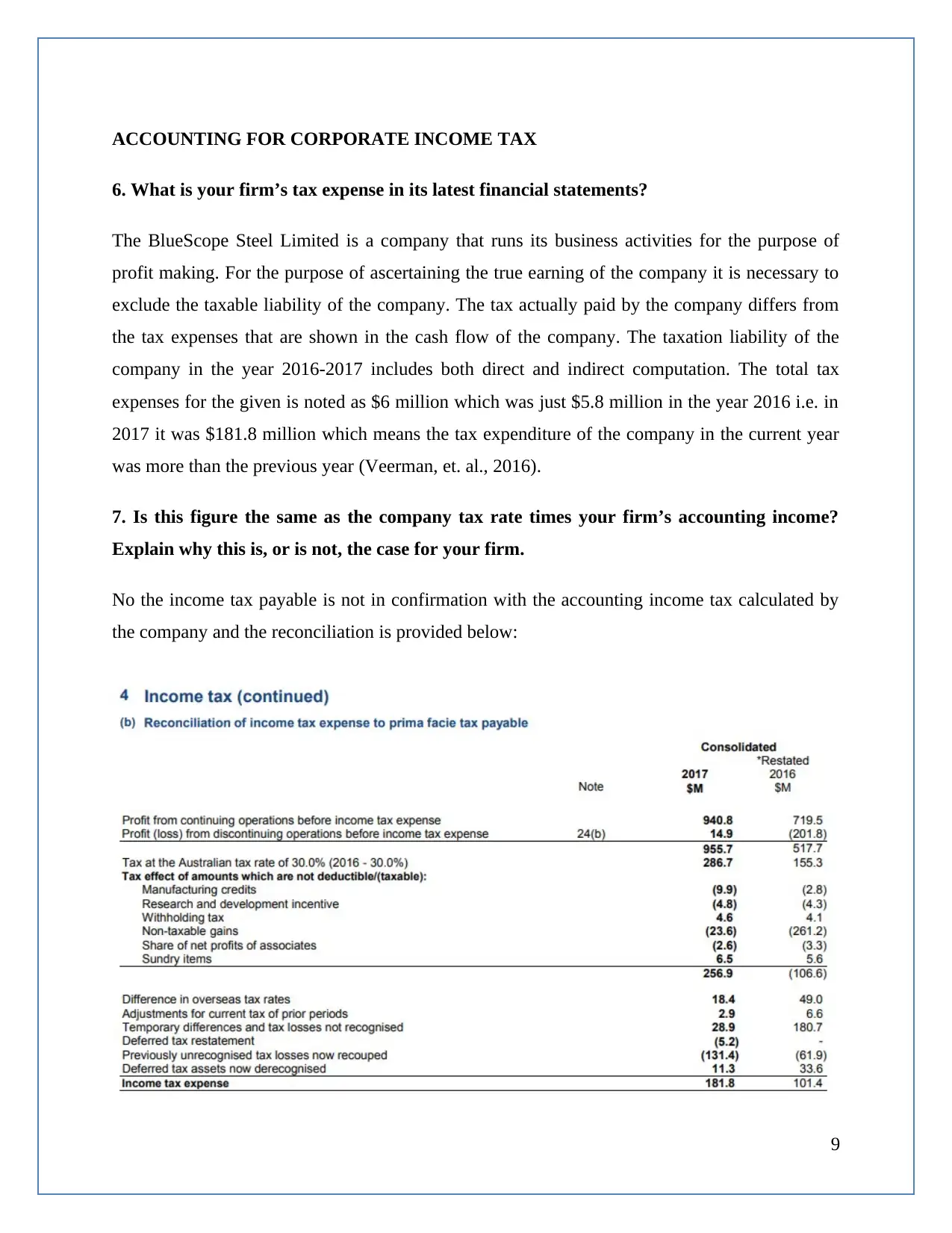
ACCOUNTING FOR CORPORATE INCOME TAX
6. What is your firm’s tax expense in its latest financial statements?
The BlueScope Steel Limited is a company that runs its business activities for the purpose of
profit making. For the purpose of ascertaining the true earning of the company it is necessary to
exclude the taxable liability of the company. The tax actually paid by the company differs from
the tax expenses that are shown in the cash flow of the company. The taxation liability of the
company in the year 2016-2017 includes both direct and indirect computation. The total tax
expenses for the given is noted as $6 million which was just $5.8 million in the year 2016 i.e. in
2017 it was $181.8 million which means the tax expenditure of the company in the current year
was more than the previous year (Veerman, et. al., 2016).
7. Is this figure the same as the company tax rate times your firm’s accounting income?
Explain why this is, or is not, the case for your firm.
No the income tax payable is not in confirmation with the accounting income tax calculated by
the company and the reconciliation is provided below:
9
6. What is your firm’s tax expense in its latest financial statements?
The BlueScope Steel Limited is a company that runs its business activities for the purpose of
profit making. For the purpose of ascertaining the true earning of the company it is necessary to
exclude the taxable liability of the company. The tax actually paid by the company differs from
the tax expenses that are shown in the cash flow of the company. The taxation liability of the
company in the year 2016-2017 includes both direct and indirect computation. The total tax
expenses for the given is noted as $6 million which was just $5.8 million in the year 2016 i.e. in
2017 it was $181.8 million which means the tax expenditure of the company in the current year
was more than the previous year (Veerman, et. al., 2016).
7. Is this figure the same as the company tax rate times your firm’s accounting income?
Explain why this is, or is not, the case for your firm.
No the income tax payable is not in confirmation with the accounting income tax calculated by
the company and the reconciliation is provided below:
9
⊘ This is a preview!⊘
Do you want full access?
Subscribe today to unlock all pages.

Trusted by 1+ million students worldwide
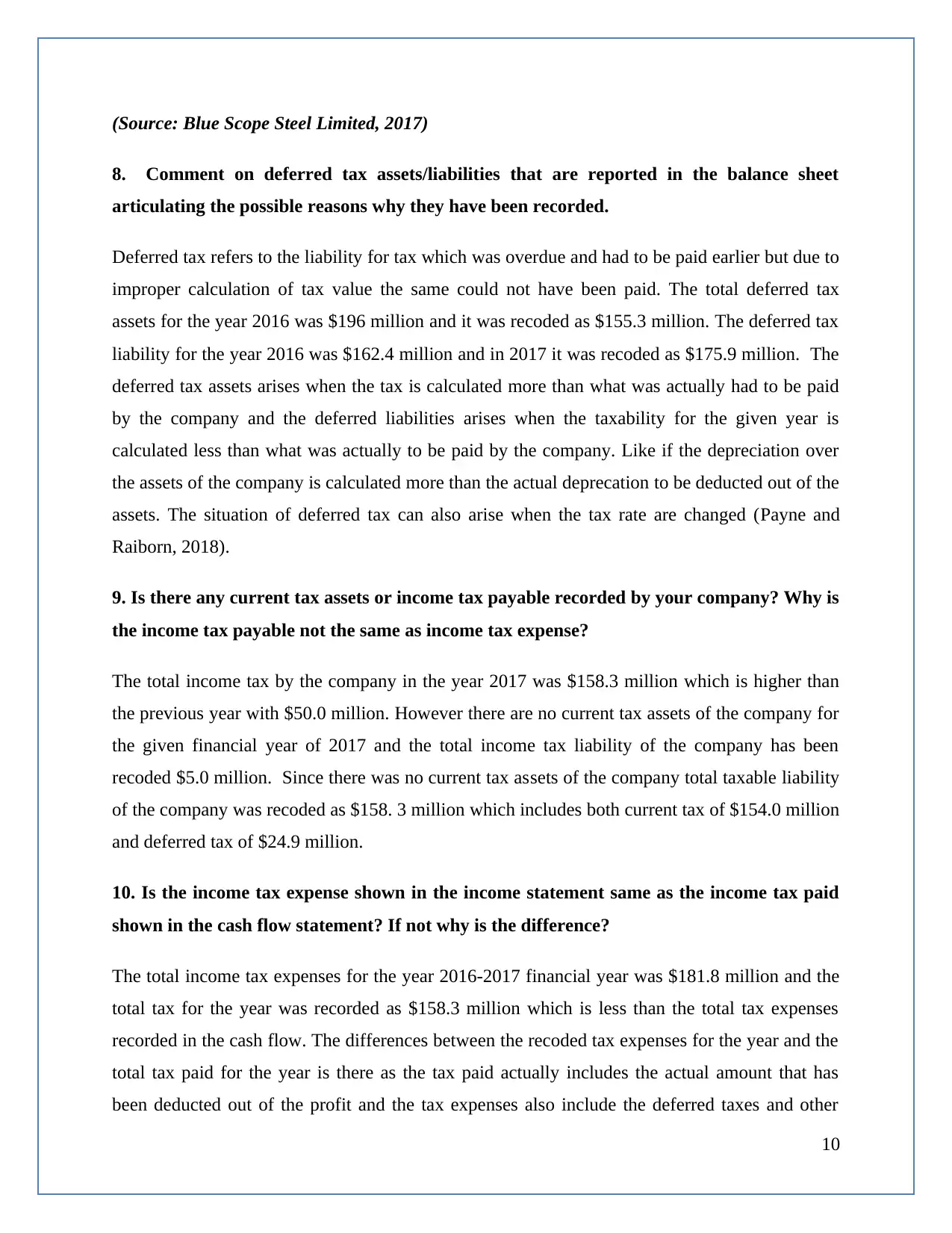
(Source: Blue Scope Steel Limited, 2017)
8. Comment on deferred tax assets/liabilities that are reported in the balance sheet
articulating the possible reasons why they have been recorded.
Deferred tax refers to the liability for tax which was overdue and had to be paid earlier but due to
improper calculation of tax value the same could not have been paid. The total deferred tax
assets for the year 2016 was $196 million and it was recoded as $155.3 million. The deferred tax
liability for the year 2016 was $162.4 million and in 2017 it was recoded as $175.9 million. The
deferred tax assets arises when the tax is calculated more than what was actually had to be paid
by the company and the deferred liabilities arises when the taxability for the given year is
calculated less than what was actually to be paid by the company. Like if the depreciation over
the assets of the company is calculated more than the actual deprecation to be deducted out of the
assets. The situation of deferred tax can also arise when the tax rate are changed (Payne and
Raiborn, 2018).
9. Is there any current tax assets or income tax payable recorded by your company? Why is
the income tax payable not the same as income tax expense?
The total income tax by the company in the year 2017 was $158.3 million which is higher than
the previous year with $50.0 million. However there are no current tax assets of the company for
the given financial year of 2017 and the total income tax liability of the company has been
recoded $5.0 million. Since there was no current tax assets of the company total taxable liability
of the company was recoded as $158. 3 million which includes both current tax of $154.0 million
and deferred tax of $24.9 million.
10. Is the income tax expense shown in the income statement same as the income tax paid
shown in the cash flow statement? If not why is the difference?
The total income tax expenses for the year 2016-2017 financial year was $181.8 million and the
total tax for the year was recorded as $158.3 million which is less than the total tax expenses
recorded in the cash flow. The differences between the recoded tax expenses for the year and the
total tax paid for the year is there as the tax paid actually includes the actual amount that has
been deducted out of the profit and the tax expenses also include the deferred taxes and other
10
8. Comment on deferred tax assets/liabilities that are reported in the balance sheet
articulating the possible reasons why they have been recorded.
Deferred tax refers to the liability for tax which was overdue and had to be paid earlier but due to
improper calculation of tax value the same could not have been paid. The total deferred tax
assets for the year 2016 was $196 million and it was recoded as $155.3 million. The deferred tax
liability for the year 2016 was $162.4 million and in 2017 it was recoded as $175.9 million. The
deferred tax assets arises when the tax is calculated more than what was actually had to be paid
by the company and the deferred liabilities arises when the taxability for the given year is
calculated less than what was actually to be paid by the company. Like if the depreciation over
the assets of the company is calculated more than the actual deprecation to be deducted out of the
assets. The situation of deferred tax can also arise when the tax rate are changed (Payne and
Raiborn, 2018).
9. Is there any current tax assets or income tax payable recorded by your company? Why is
the income tax payable not the same as income tax expense?
The total income tax by the company in the year 2017 was $158.3 million which is higher than
the previous year with $50.0 million. However there are no current tax assets of the company for
the given financial year of 2017 and the total income tax liability of the company has been
recoded $5.0 million. Since there was no current tax assets of the company total taxable liability
of the company was recoded as $158. 3 million which includes both current tax of $154.0 million
and deferred tax of $24.9 million.
10. Is the income tax expense shown in the income statement same as the income tax paid
shown in the cash flow statement? If not why is the difference?
The total income tax expenses for the year 2016-2017 financial year was $181.8 million and the
total tax for the year was recorded as $158.3 million which is less than the total tax expenses
recorded in the cash flow. The differences between the recoded tax expenses for the year and the
total tax paid for the year is there as the tax paid actually includes the actual amount that has
been deducted out of the profit and the tax expenses also include the deferred taxes and other
10
Paraphrase This Document
Need a fresh take? Get an instant paraphrase of this document with our AI Paraphraser
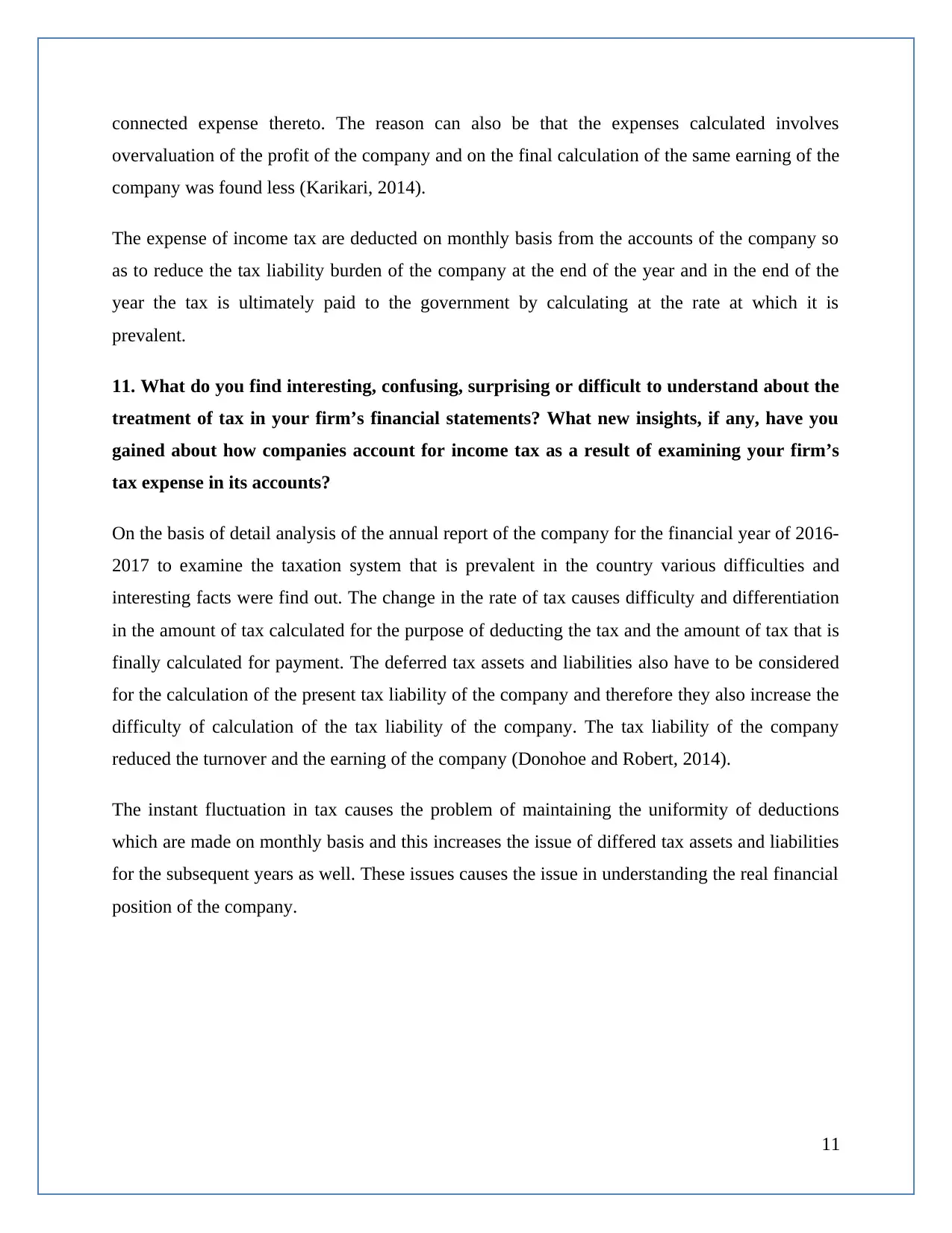
connected expense thereto. The reason can also be that the expenses calculated involves
overvaluation of the profit of the company and on the final calculation of the same earning of the
company was found less (Karikari, 2014).
The expense of income tax are deducted on monthly basis from the accounts of the company so
as to reduce the tax liability burden of the company at the end of the year and in the end of the
year the tax is ultimately paid to the government by calculating at the rate at which it is
prevalent.
11. What do you find interesting, confusing, surprising or difficult to understand about the
treatment of tax in your firm’s financial statements? What new insights, if any, have you
gained about how companies account for income tax as a result of examining your firm’s
tax expense in its accounts?
On the basis of detail analysis of the annual report of the company for the financial year of 2016-
2017 to examine the taxation system that is prevalent in the country various difficulties and
interesting facts were find out. The change in the rate of tax causes difficulty and differentiation
in the amount of tax calculated for the purpose of deducting the tax and the amount of tax that is
finally calculated for payment. The deferred tax assets and liabilities also have to be considered
for the calculation of the present tax liability of the company and therefore they also increase the
difficulty of calculation of the tax liability of the company. The tax liability of the company
reduced the turnover and the earning of the company (Donohoe and Robert, 2014).
The instant fluctuation in tax causes the problem of maintaining the uniformity of deductions
which are made on monthly basis and this increases the issue of differed tax assets and liabilities
for the subsequent years as well. These issues causes the issue in understanding the real financial
position of the company.
11
overvaluation of the profit of the company and on the final calculation of the same earning of the
company was found less (Karikari, 2014).
The expense of income tax are deducted on monthly basis from the accounts of the company so
as to reduce the tax liability burden of the company at the end of the year and in the end of the
year the tax is ultimately paid to the government by calculating at the rate at which it is
prevalent.
11. What do you find interesting, confusing, surprising or difficult to understand about the
treatment of tax in your firm’s financial statements? What new insights, if any, have you
gained about how companies account for income tax as a result of examining your firm’s
tax expense in its accounts?
On the basis of detail analysis of the annual report of the company for the financial year of 2016-
2017 to examine the taxation system that is prevalent in the country various difficulties and
interesting facts were find out. The change in the rate of tax causes difficulty and differentiation
in the amount of tax calculated for the purpose of deducting the tax and the amount of tax that is
finally calculated for payment. The deferred tax assets and liabilities also have to be considered
for the calculation of the present tax liability of the company and therefore they also increase the
difficulty of calculation of the tax liability of the company. The tax liability of the company
reduced the turnover and the earning of the company (Donohoe and Robert, 2014).
The instant fluctuation in tax causes the problem of maintaining the uniformity of deductions
which are made on monthly basis and this increases the issue of differed tax assets and liabilities
for the subsequent years as well. These issues causes the issue in understanding the real financial
position of the company.
11
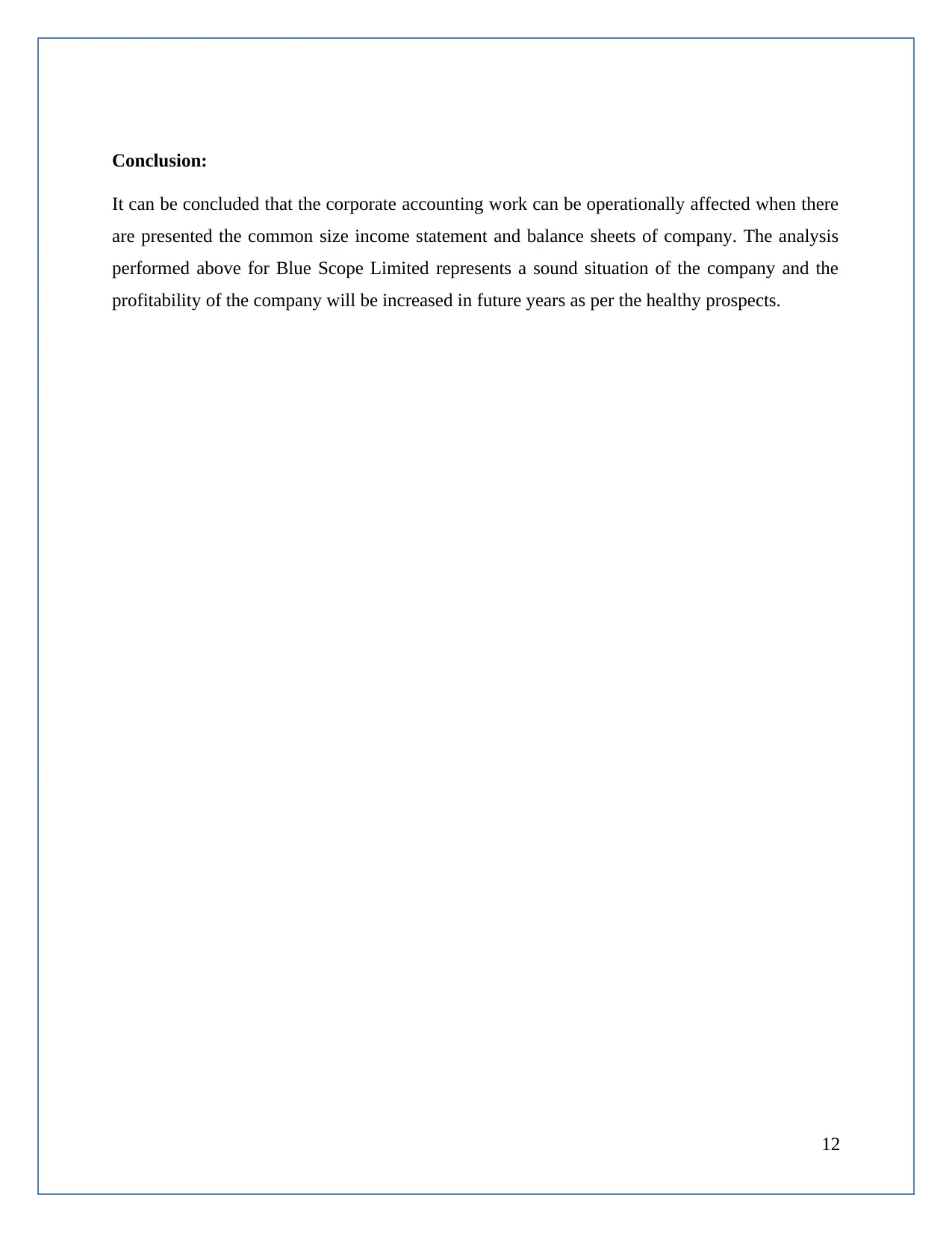
Conclusion:
It can be concluded that the corporate accounting work can be operationally affected when there
are presented the common size income statement and balance sheets of company. The analysis
performed above for Blue Scope Limited represents a sound situation of the company and the
profitability of the company will be increased in future years as per the healthy prospects.
12
It can be concluded that the corporate accounting work can be operationally affected when there
are presented the common size income statement and balance sheets of company. The analysis
performed above for Blue Scope Limited represents a sound situation of the company and the
profitability of the company will be increased in future years as per the healthy prospects.
12
⊘ This is a preview!⊘
Do you want full access?
Subscribe today to unlock all pages.

Trusted by 1+ million students worldwide
1 out of 14
Related Documents
Your All-in-One AI-Powered Toolkit for Academic Success.
+13062052269
info@desklib.com
Available 24*7 on WhatsApp / Email
![[object Object]](/_next/static/media/star-bottom.7253800d.svg)
Unlock your academic potential
Copyright © 2020–2026 A2Z Services. All Rights Reserved. Developed and managed by ZUCOL.





